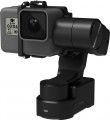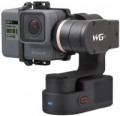Type
—
For smartphone. Mount for using a smartphone as a camera. Most often it is a kind of clamp, in which the body of the device is tightly clamped. Such clamps usually have a fairly wide range of adjustment for the width of the phone, which allows you to use this type of stabiliser with most modern smartphones, regardless of the diagonal. And some models can even work with compact digital cameras.
—
For camera. Attachments designed for use with full-size cameras — SLR and mirrorless (MILC). Such cameras are quite large and have a thread mount for a tripod. All these features are taken into account in the design of the stabiliser.
—
For action cameras. Stabilisers designed for action cameras — compact cameras used mainly for shooting dynamic scenes like sports, skiing, cycling, etc. Such devices, by definition, are designed for use in rather extreme activities, including surfing, skiing, paragliding, etc. However, the specific features of different stabilisers may be different, so before buying it's ok to clarify this matter separately. Note that instead of the general name “for action camera”, the stabiliser specifications may contain the names of specific models of action cameras for which the device is designed.
—
With camera. Stabilizers equipped with their own cameras. These are integrated directly int
...o the stabilizer's construction, eliminating the need for external devices for filming. Moreover, such models are inherently optimized for working with the built-in camera — at the very least, the user doesn't have to deal with balancing the load on the stabilizer's head. Note that the ability to remove and replace the camera with another is usually not provided, although there are occasional exceptions to this rule.Functions
—
Time lapse. The ability to use a stabiliser for shooting video in time-lapse mode. In this mode, shooting is carried out at a very low frame rate (one frame every few seconds, or even minutes), due to which the effect of fast movement is achieved in the finished video (for example, a day from sunrise to sunset can fit in several minutes). However, this is the general principle of time lapse; but the specific ways of its implementation may be different.
—
Selfie shooting. The presence of a separate mode for shooting selfies.
—
Sports mode. It allows you to use the stabiliser when shooting in extreme conditions, on the go and even while running. If you turn on the sport mode, the stabilizer begins to compensate for even deep and sharp frame deviations. Of course, an increase in the potential of the stabilizer affects the charge of the battery pack — the sport mode significantly speeds up the process of discharging the battery.
—
Panorama. The presence of the mode of automatic shooting of panoramas in the design of the stabiliser. In this mode, the camera attached to the device automatically rotates, taking a series of shots, from which the finished panoramic image is then “glued together”. Most often, this function involves the creation of horizontal panoramas, but it can also provide the movement of th
...e camera vertically.
— Fixing camera position. The ability to fix the position of the camera mounted on the stabiliser. Fixation means such a mode of operation in which the camera remains constantly directed in the same direction, regardless of the position of the stabiliser itself.
— Axis lock. The presence of an axis lock in the design of the stabiliser — in such a way that when turning along this axis, the camera will follow the movement of the stand. Such an opportunity is necessary in cases where there is a need for precise and operational control over the movement of the camera.
— Tracking mode. The presence of an automatic tracking mode in the stabiliser. By the name, in this mode the device automatically follows a certain object, turning the camera so that this object is constantly in the centre of the image, or at least in the frame. In this case, the subject for tracking can be set by the operator himself.
— Inversion mode. The presence of the inversion mode in the design of the stabiliser. This function, as the name suggests, allows you to turn the device upside down, keeping all its functions and the position of the camera.
— The control wheel allows you to speed up and simplify the setting of the stabiliser operating modes. The wheel is designed to complement the keypad, but in some cases, it can replace the buttons completely. Typically, the control wheel is used to adjust the sensitivity of the gimbal, as well as rotate and lock the camera mounting pad. If the optics are fully compatible with the stabiliser, then the control wheel can be used to adjust both focus with zoom and many other filming parameters.Connection
There are two main types of connection in modern stabilisers:
Wi-Fi(more precisely, Wi-Fi Direct — for direct communication between devices) and
Bluetooth. Despite the difference from a technical point of view, in this case, these standards are very similar. First, they are both wireless. Secondly, both are used for direct connection with devices installed on the stabiliser — smartphones, action cameras, etc. (for more details, see "Features"). Thirdly, the specific functions of such a connection may be different, they should be specified separately for each model. However, such functions usually include at least control over the recording process (start/pause video recording, capture photos). So the main selection criterion for this indicator is what technology the connected gadget supports — Wi-Fi or Bluetooth.
Separately, we note that there are stabilisers that support both standards at once — these are mainly expensive professional models for cameras (see "Features"), where Wi-Fi is used to transfer video to an external screen, and Bluetooth is used for basic remote control.
Dustproof, waterproof
The presence in the stabiliser design
protection against dust and moisture, and the level of such protection.
Any device has a certain degree of dust and water protection; however, in this case, an increased degree of security is implied, at least allowing you to safely use the stabiliser in the rain. In general, the degree of such protection may be different. Sometimes it is not indicated at all, and this parameter needs to be clarified according to the documentation for the device. Sometimes a specific level of protection is given by the IP standard — for example, IP67. A detailed interpretation of such markings can be found in special tables.

